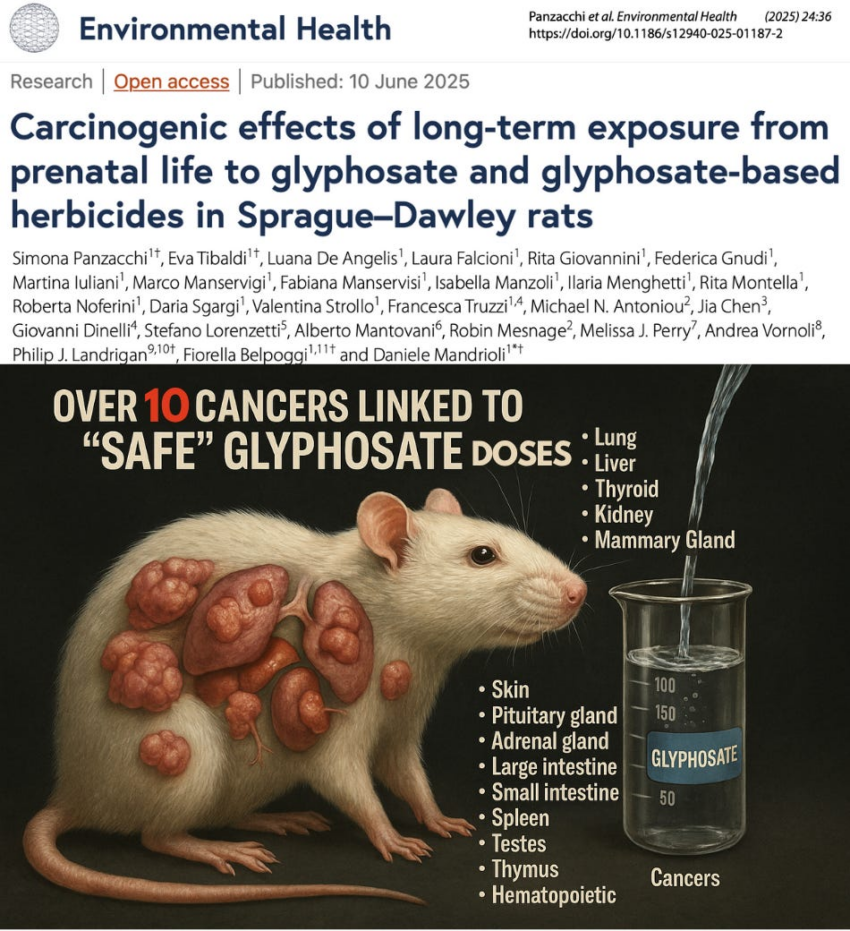By
Background
Glyphosate-based herbicides (GBHs) are the world’s most widely used weed control agents. Public health concerns have increased since the International Agency for Research on Cancer (IARC) classified glyphosate as a probable human carcinogen in 2015. To further investigate the health effects of glyphosate and GBHs, the Ramazzini Institute launched the Global Glyphosate Study (GGS), which is designed to test a wide range of toxicological outcomes. Reported here are the results of the carcinogenicity arm of the GGS.
Methods
Glyphosate and two GBHs, Roundup Bioflow used in the European Union (EU) and RangerPro used in the U.S., were administered to male and female Sprague–Dawley (SD) rats, beginning at gestational day 6 (via maternal exposure) through 104 weeks of age. Glyphosate was administered through drinking water at three doses: the EU acceptable daily intake (ADI) of 0.5 mg/kg body weight/day, 5 mg/kg body weight/day and the EU no-observed adverse effect level (NOAEL) of 50 mg/kg body weight/day. The two GBH formulations were administered at the same glyphosate-equivalent doses.
Results
In all 3 treatment groups, statistically significant dose-related increased trends or increased incidences of benign and malignant tumors at multiple anatomic sites were observed compared to historical and concurrent controls. These tumors arose in haemolymphoreticular tissues (leukemia), skin, liver, thyroid, nervous system, ovary, mammary gland, adrenal glands, kidney, urinary bladder, bone, endocrine pancreas, uterus and spleen (hemangiosarcoma). Increased incidences occurred in both sexes. Most of these involved tumors that are rare in SD rats (background incidence < 1%) with 40% of leukemias deaths in the treated groups occurring before 52 weeks of age and increased early deaths were also observed for other solid tumors.
Conclusions
Glyphosate and GBHs at exposure levels corresponding to the EU ADI and the EU NOAEL caused dose-related increases in incidence of multiple benign and malignant tumors in SD rats of both sexes. Early-life onset and mortality were observed for multiple tumors. These results provide robust evidence supporting IARC’s conclusion that there is “sufficient evidence of carcinogenicity [of glyphosate] in experimental animals”. Furthermore, our data are consistent with epidemiological evidence on the carcinogenicity of glyphosate and GBHs.
Now, let’s dive into their study design and major findings.
Study Design
-
Subjects: 1,020 Sprague–Dawley rats (510 males, 510 females)
-
Exposure: Began in utero (gestational day 6) and continued for 104 weeks (2 years)
-
Tested Substances:
-
Pure glyphosate
-
Roundup Bioflow (EU formulation without POEA surfactants)
-
RangerPro (U.S. formulation with POEA surfactants)
-
-
Doses: Equivalent to the European Union Acceptable Daily Intake (0.5 mg/kg/day), an intermediate level (5 mg/kg/day), and the European Union No Observed Adverse Effect Level (50 mg/kg/day)
Major Findings
1. Significant Dose-Dependent Increases in Tumors
-
Tumors observed in multiple organs, including:
-
Leukemia (lymphoblastic, monocytic, myeloid)
-
Skin (e.g., squamous cell papillomas, keratoacanthomas, trichoepitheliomas)
-
Liver (hepatocellular carcinomas)
-
Thyroid (follicular and C-cell carcinomas)
-
Bone (chondromas, osteomas, and osteosarcomas)
-
Pancreas, adrenals, uterus, and central/peripheral nervous system
-
2. Early-Onset Leukemia
-
40% of leukemias in treated animals occurred before 1 year of age
-
Control animals had zero cases of leukemia
-
Historical controls showed leukemia incidence <1% and no early deaths
3. Rare Tumors Elevated
-
Multiple tumors with <1% historical control prevalence were significantly increased
-
Includes: malignant Schwannomas, malignant granular cell brain tumors, trichoepitheliomas, and pancreatic islet cell carcinomas
4. Consistent Across Formulations
-
Both glyphosate alone and GBH formulations (Roundup Bioflow and RangerPro) increased tumor incidence
-
RangerPro (with POEA) often showed stronger carcinogenic trends than Roundup Bioflow
These experimental findings are consistent with a study by Zhang et al, who found a statistically significant association between glyphosate exposure and increased risk of non-Hodgkin lymphoma (NHL) in humans. Their 2019 meta-analysis pooled data from over 65,000 participants across six studies—including more than 7,000 NHL cases—and reported a 41% increased risk of NHL among those with the highest glyphosate exposure:
Together, these animal and human data provide strong evidence of glyphosate’s carcinogenic potential and underscore the urgent need to eliminate its use entirely and replace it with demonstrably non-carcinogenic alternatives.
Aside from cancer, glyphosate has also been linked to neurodevelopment disorders and autism:
Epidemiologist and Foundation Administrator, McCullough Foundation
www.mcculloughfnd.org
Please consider following both the McCullough Foundation and my personal account on X (formerly Twitter) for further content.
References
Panzacchi S, Tibaldi E, De Angelis L, et al. Carcinogenic effects of long-term exposure from prenatal life to glyphosate and glyphosate-based herbicides in Sprague-Dawley rats. Environ Health. 2025;24(1):36. Published 2025 Jun 10. doi:10.1186/s12940-025-01187-2
Zhang L, Rana I, Shaffer RM, Taioli E, Sheppard L. Exposure to glyphosate-based herbicides and risk for non-Hodgkin lymphoma: A meta-analysis and supporting evidence. Mutat Res Rev Mutat Res. 2019;781:186-206. doi:10.1016/j.mrrev.2019.02.001









